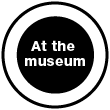


 |
||
 |
||
|
We are highly sensitive to slight differences in brightness when these areas separated by strong borders. The Mach Band phenomenon occurs on the border between the light and dark strips. The dark edge along the border appears darker, and the light edge along the border appears lighter. As a result, it the brightness seems to vary over the entire figure. In most instances, objects are illuminated by graded rather than uniform light. Think about a sheet of paper on a desk, and a lamp placed at one corner of the desk. The further away from lamp, the weaker the light that projects onto (and is reflected back from) the paper. These gradual changes contribute almost no information about the illuminated object. Therefore, we've lost our sensitivity to them. However, we are highly sensitive to slight changes in brightness if the areas are separated by a strong border. This phenomenon has nothing to do with lighting. The neural mechanism responsible for defining borders is called "lateral inhibition," and it takes place mainly in the retina of the eye. A visual stimulus at any point in the visual field inhibits, or lessens, the reaction to other visual stimuli nearby. The stronger the stimulus, the stronger the inhibition. Therefore, if two different areas have two different levels of brightness, the brighter area inhibits the reaction to the darker area more than the darker area inhibits the reaction to the brighter area. The result is that the differences in brightness we perceive are accentuated. This mechanism creates a situation in which the perceived brightness of a surface is always lessened by stimuli from neighboring surfaces. The brighter those neighboring surfaces, the more they detract from the brightness of surface we're looking at. In essence, the lateral inhibition mechanism is localized and its area of influence quite limited. Therefore, the reaction to the area along the border on the dark side is inhibited more than the reaction to the area further from the border in that same area. That is why we perceive that strip along the border to be darker (a Mach Band) than the rest of the dark area. Similarly, the area along the border on the light side appears to be lighter. Links: Related exhibits:
|
||

 Clear Boundaries
Clear Boundaries